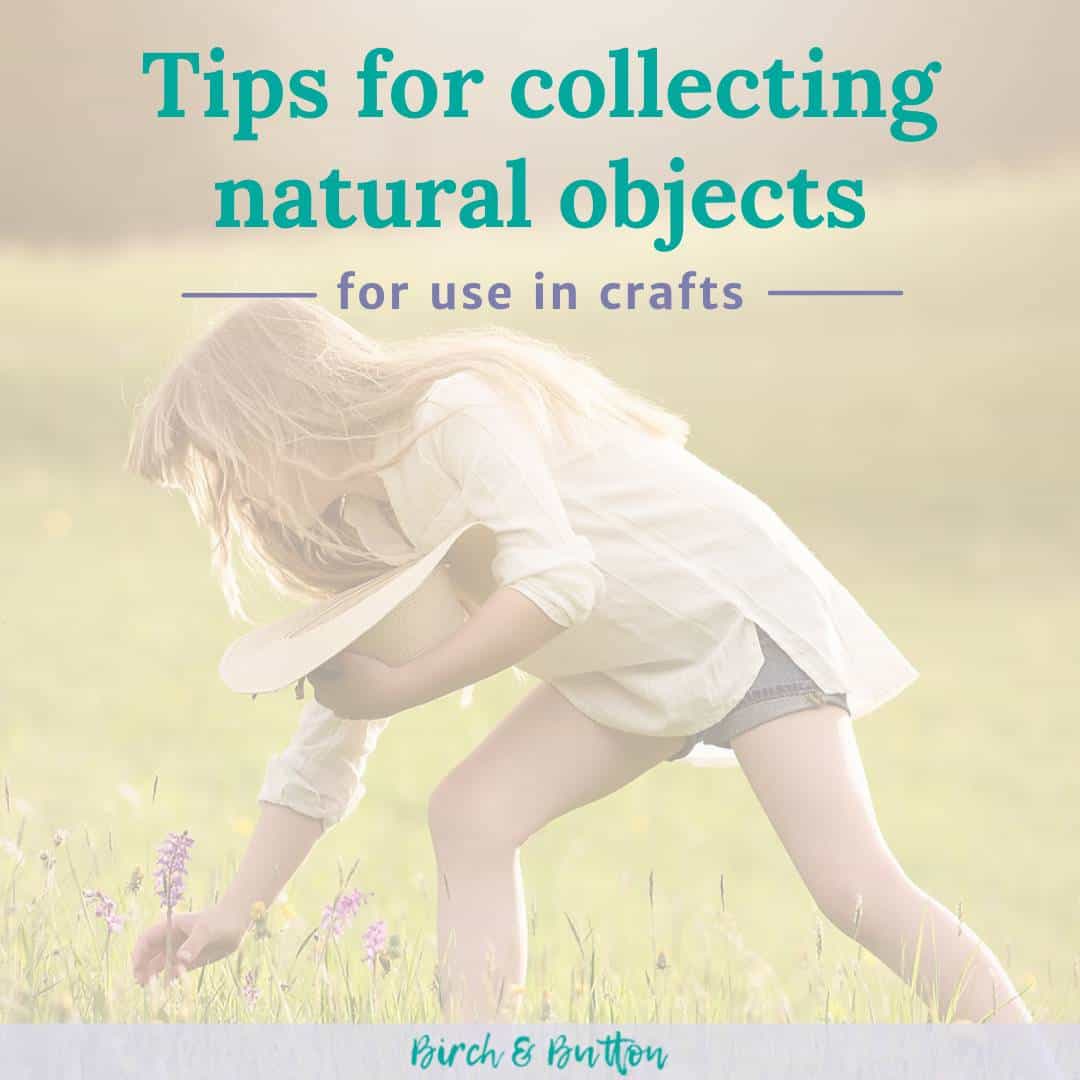Collecting natural objects when you’re out and about enjoying the fresh air is a great way to find craft materials.
You’ll find all kinds of inspiring and beautiful items regardless of where you are. And this post is designed to give you a bit of guidance about the rules and etiquette involved.
Sign up for my monthly emails of creative tips, tutorials and DIYs and get 31 free creative prompts!

You can unsubscribe at any time
Suggestions for natural items to collect
First things first: here’s a list of the things you could collect for use in your craft projects:
- Shells
- Pebbles
- Driftwood
- Feathers
- Leaves
- Flowers
- Pine cones
- Sycamore seeds (I used to call them “helicopters” when I was little!)
- Acorns
- Sticks
- Sea glass (technically rubbish but often beautiful, so you can collect as much of this as you like!)
For more inspiration, take a look at my Pinterest board Crafts Using Nature. Find a project you want to try and then think about where you might find the natural materials!
Collecting natural objects from living plants, trees and flowers
On the whole, it’s easiest to collect leaves and sticks etc that have fallen naturally. But it’s okay to cut flowers and leaves from living plants too, as long as you abide by a few rules.
(Bear in mind I’ve only researched the rules in the UK. If you’re in another country or in doubt of your local laws, always check before picking something that hasn’t already fallen.)
According to Plantlife, it’s ok to pick wildflowers, leaves and berries “for personal, non-commercial use.” There are a few exceptions, however, such as highly threatened plants and any plants on sites designated for conservation interest.
You also mustn’t uproot a whole plant to replant elsewhere (like your garden) – but as you’ll be collecting items for use in crafts, you’ll just be snipping off the bits you want.
Be selective, don’t be wasteful, and don’t take too much from one plant. If there are a number of the same plants in an area, take a little from each plant rather than just from one. This is especially important with small plants.
Leave the surrounding area as undisturbed as possible. And especially in the spring, be mindful of birds or other animals that may be nesting nearby.
But if you’re walking in your local park, beware. Don’t pick anything cultivated as it can be considered criminal damage or theft, as innocent and harmless as it may seem.
For a bit more information on the rules surrounding flower-picking, take a look at this Guardian article.

The dos and don’ts of collecting from nature
- DO keep your eyes peeled when out and about. A walk on the beach or through a forest can yield some fantastic stuff.
- DO get out and about often! I have nothing more to say on this, because why would you need convincing?
- DO work with Mother Nature! The weather can make a huge difference in what’s available to collect. The morning after a storm can be great for collecting stuff that has been washed up on a beach, and similarly a windy day can be great for collecting leaves or pine cones that have just fallen.
- DO consider the seasons. If you’re looking for flowers and deciduous leaves, winter isn’t the time to do it. Also consider the seasons of the particular things you’re looking for. For example, spring is the season for tulips and daffodils whereas peonies are lovely during the summer and marigolds in the autumn. Winter is a great time to wrap up warm and get beachcombing!
- DON’T pull bark from a living tree; instead, collect it from a fallen log. Since these can be few and far between, it pays to keep your eyes open whenever you are out and about if you fancy trying a craft project incorporating bark.
- DON’T over collect. Remember that certain items are vital for keeping the beach habitat balanced, such as washed up shells and driftwood. Taking a few bits and pieces is one thing, but leaving the beach with bucketfuls is not on. You also shouldn’t take rocks from the beach, as they are important for combating coastal erosion.
- DON’T pick anything endangered or protected. If in doubt, leave it where it is.
- DON’T venture onto private property for the sake of a pretty pebble or leaf. Anything on private property belongs to the landowner…and yes, that means even the thistles and dandelions!
So as you can see, there are many natural objects that could be useful in crafts and it’s a lot of fun collecting them providing you do so safely and responsibly.
Above all, if something appeals to you or intrigues you, pick it up and find a use for it later! (I’m soooo guilty of this… 😅)
(Images: Title image from Pixabay, pine cone by inyucho on Flickr.)
About Stacey

I’m Stacey and I’m a blogger, abstract artist and freelance writer. My aim is to help busy people feel inspired and get more creative with tutorials, hints and tips.
I live in Cardiff with my partner and dog, and in my free time you’ll find me hiking, reading, painting or sampling a craft beer or two.

